CHA Tabard
Hart House
St. Bart's
Queen's Beasts
The Greaves Canadian Heraldic Dictionary


| Term | Source | Meaning | Illustration |
| Fan | Wilgress | A Canadian term for a display of feathers – a variant of the more traditional plume (in British heraldry, the term fan usually refers to a winnowing-fan). |  |
| Fenghuang | Wong Kung Har Wun Sun Association. Vol VI, P 56 |  The Fenghuang or Chinese Phoenix is a symbol of peace and prosperity. The Fenghuang or Chinese Phoenix is a symbol of peace and prosperity. |
 |
| Ferruginous Hawk | Town of Morinville, Alberta. Vol IV, P 281 |  The Ferruginous Hawk (so named for its rust-coloured breast) is the largest of the North American buteo hawks, often mistaken for an eagle. The Ferruginous Hawk (so named for its rust-coloured breast) is the largest of the North American buteo hawks, often mistaken for an eagle. |
 |
| Fiddlehead Coronet | McCain, M.N., Vol III, P 22 |  This distinctively Canadian Coronet uses the fiddlehead fronds to suggest the Province of New Brunswick, where they are a commercial crop. This distinctively Canadian Coronet uses the fiddlehead fronds to suggest the Province of New Brunswick, where they are a commercial crop. |
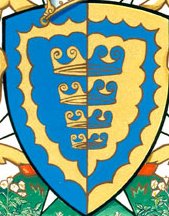 |
| Field Battery Gun | Rigby, F.N., (Banner) Vol V, P 128 |  The Field Gun is so-called because it is transportable on the battlefield. The gun pictured dates to the 18th Century, and is used to refer to artillery in general. The Field Gun is so-called because it is transportable on the battlefield. The gun pictured dates to the 18th Century, and is used to refer to artillery in general. |
 |
| Fireweed - Heraldic | Yukon Territory (Flag) Vol VI, P 11 |  The Fireweed is the Territorial flower of the Yukon. The Fireweed is the Territorial flower of the Yukon. |
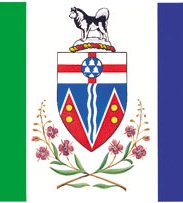 |
| Fireweed Flower - Natural | Provincial Flowers of Canada |  The Fireweed, shown here in its natural form, is the Territorial flower of the Yukon. The Fireweed, shown here in its natural form, is the Territorial flower of the Yukon. |
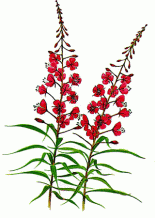 |
| Flatbed Printing Press | Clarke, C. J.oseph. Vol II, P 369 | The Flatbed Press, in which the paper is compressed between two flat surfaces, one of them with inked type, goes back in Europe to the late Middle ages. It has been largely replaced by the much larger, electric presses of today, but is still used for hand-printing small or very specialized runs of print. It alludes to the family’s association with newspapers and journalism. | 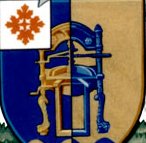 |
| Flint Spearhead | HMCS Anticosti (Badge) Vol II, P 407 |  Anticosti is a large island located where the St. Lawrence River enters the Gulf of St. Lawrence. Before the arrival of Europeans in 1534, it was an important hunting ground for native peoples, mostly Micmac and Innu. The Flint Spearhead is a reference to their weapons, as it is to weapons in general. Anticosti is a large island located where the St. Lawrence River enters the Gulf of St. Lawrence. Before the arrival of Europeans in 1534, it was an important hunting ground for native peoples, mostly Micmac and Innu. The Flint Spearhead is a reference to their weapons, as it is to weapons in general. |
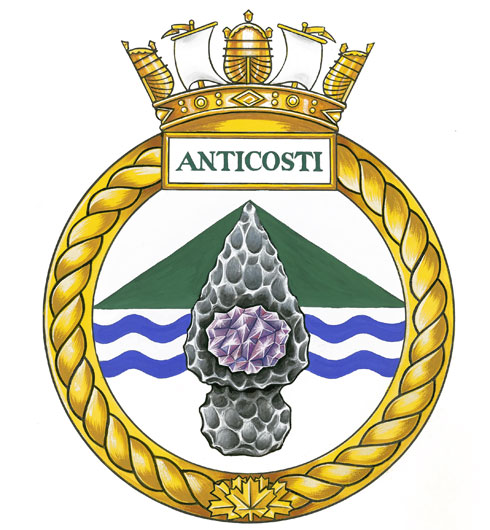 |
| Flotant | Gary A. Mitchell |  The term flotant (usually reserved in British blazon to a charge floating in the air), has been used in Canadian practice to apply to a creature – such as the otter shown here – floating on its back in water. The term flotant (usually reserved in British blazon to a charge floating in the air), has been used in Canadian practice to apply to a creature – such as the otter shown here – floating on its back in water. |
 |
| Fly Fishing Rod | Clements, G.R. Vol III, P 130 |  The Fly Fishing Rod refers to the grantee’s enthusiasm for the sport. The Fly Fishing Rod refers to the grantee’s enthusiasm for the sport. |
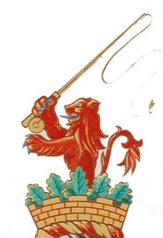 |
| Foil | St. Paul's Cathedral, Regina | The blazon of the arms notes "foils of poplar " as being on the bordure. Here the word foil has been coined to refer to the outline or shape of a stemmed leaf, without veins or other features, on the same principle as the terms trefoil and cinquefoil, which refer to multi-lobed leaves (Latin folium). The shape, as indicated, is that of a poplar leaf. | 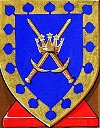 |
| Fox, Arctic | Melançon, R.F., Vol VI, P 89 |  The white or Arctic Fox is a characteristic animal of the Canadian north. It may also be used to symbolize the idea of winter. The white or Arctic Fox is a characteristic animal of the Canadian north. It may also be used to symbolize the idea of winter. |
 |
| Franciscan Cord | Assoc. des Bourgeois de Descendance Acadienne. Vol VI, P 274 |  The Franciscan Cord refers to the cords that gird the robes of Franciscan Friars. Here it alludes to the ship, Saint Francois, on which the original Jacques Burgeois arrived at Port-Royal. The Franciscan Cord refers to the cords that gird the robes of Franciscan Friars. Here it alludes to the ship, Saint Francois, on which the original Jacques Burgeois arrived at Port-Royal. |
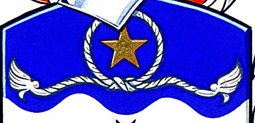 |






